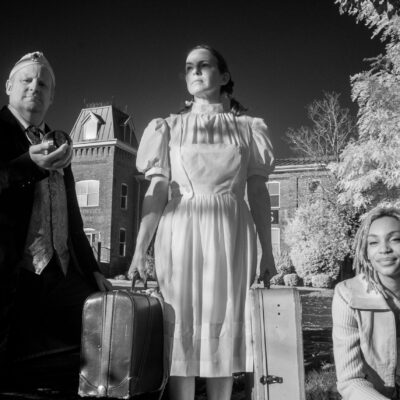
James Brown
Charlottesville Pavilion
Thursday, May 25
music
Any song from the catalogue of the Godfather of Soul threatens to throw the stuffiest, stodgiest room into hysterics. Whether they boom from within the tired frame of a barroom jukebox or seep from the weary pipes of a hired party singer, songs from “Papa’s Got a Brand New Bag” to “I Feel Good” never fail to shake crowds into motion.
What, then, is the draw of a live performance by a man who many argue peaked in 1962 at the Apollo? Would it be admirable or miserable to witness James Brown tear through up-tempo classics to the best of his abilities?
The maximum capacity crowd turned out early at the Charlottesville Pavilion last Thursday to dance as the five-piece opening act, Powerplay, fused classic soul standards with a Caribbean kick. The band’s crisp rhythm section and use of prerecorded drum tracks carried a set of otherwise predictable covers that spanned Barry White to Prince.
Brown’s nine-piece band took the stage at 8:45pm in crisp blue suits, flanked by the Bittersweets—a quartet of fringe-dressed and gloss-lipped peacocks—and Danny Ray, the evening’s master of ceremonies. Ray led the audience and band in choruses of “Get up! Get up!” and “Make it funky!” until the Godfather obliged the churning, writhing crowd.
Brown popped and shimmied his way from “Get Up Off of That Thing” straight through “Get on the Good Foot.” A punchy “Living in America” and a gleaming rendition of “It’s a Man’s Man’s Man’s World” elevated the middle of the set; Brown punctuated each with staggered yelps and bits of lyrics, and occasionally slipped out of key, or found the ceiling on his octaves to be a bit lower than expected.
Grooves change in 40 years, but Brown has never abandoned his popular songs for a new aesthetic track. It is the persistence of this fiery geriatric—who capped the evening with “Sex Machine,” no less—that perpetuates the timelessness of his music, and the size of his crowd.—Brendan Fitzgerald
Taking the Long Way
Dixie Chicks
Sony Records
cd
For better or for worse, the Dixie Chicks remain frozen in amber. It’s still 2003, and they’re still on that infamous London stage. Natalie Maines’ mouth is still half-open, her bandmates standing beside her, wearing those half-amused, half-nervous expressions on their faces, and her words still hang there, sharp and bitter and pungent, egging on the ecstatic crowd: “We’re ashamed the President of the United States is from Texas.”
At that moment, country music’s twangy queens of cute stepped off a cliff, and, in some ways, they’ve been suspended there ever since. Through all of the blowback—the anger, the death threats, the half-hearted apologies—it seemed that no one really knew if the Chicks could recover. Or even if they wanted to.
Well, here it is three years later, and the answer has finally arrived, accompanied by a sugary sweet smile and a defiant one-finger salute. No, the Dixie Chicks haven’t turned their backs on their fan base, recording a politically charged jeremiad, a la Neil Young. But neither have they retreated into their comfortable Nashville shell and produced a nonoffensive new country confection. Instead, the Chicks have forged an ingenious middle path, keeping the gorgeous three-part harmonies and weeping pedal steel guitar, but adding an angry, unapologetic lyrical aggression that transforms the material from simply pretty to punch-in-the-gut affecting.
Of course, anyone who expected the cheerful, docile Dixie Chicks to suddenly re-emerge really wasn’t paying attention. Maines and company were obviously deeply affected by the furor surrounding their comments, and wore their scars publicly and proudly (most notably on the cover of Entertainment Weekly, where they posed naked, covered in insults and epithets). And any lingering doubts about their stance surely evaporated with the release of Long Way’s first single, “Not Ready to Make Nice,” with its soaring, ferocious chorus: “I’m not ready to make nice, I’m not ready to back down, ‘cause I’m mad as hell, and I don’t have time to go round and round and round.”
The rest of the album doesn’t maintain quite that level of indignation, but it comes pretty damn close. Amazingly, however, it rarely comes across as hectoring or ham-fisted (unlike, say, Neil Young’s Living With War). There are the occasional forehead-smacking lyrical clunkers, such as “Children lose their youth too soon/ watching war made us immune” (from “The Easy Silence”), and the Chicks’ harmonies sometimes take on a grating, whiney edge (especially in “Bitter End”), but such moments are few and far between. For the most part, Taking the Long Way is a beautifully realized, achingly personal and impressively uncompromised piece of work—at once easy listening and tough-talking, down home and worldly wise. Against all odds, the Dixie Chicks have left that cliff far behind—and, instead of plunging into oblivion, as so many small-minded philistines might have wished, they have taken glorious flight.—Dan Catalano
Mockingbird, A
Portrait of Harper Lee
By Charles J. Shields
Henry Holt and Company, 337 pages
words Three great mysteries pepper the modern American literary landscape. First, there’s J.D. Salinger’s full-scale retreat from public life, and his impossible-to-substantiate claim (which he’ll supposedly repeat to whoever dares knock on the door of his Cornish, New Hampshire, home) that he still writes. Then there’s Thomas Pynchon’s almost militant protection of his privacy (who knows what the guy even looks like, let alone where he lives?). But perhaps the most intriguing of all is why Harper Lee (born Nelle Harper Lee in 1926, and still alive) wrote one magnificent, massively popular, greatly loved novel—To Kill A Mockingbird—when she was still in her 30s, and has never produced, or published, an encore.
If you’re keeping score at home, a few biographers, starting with Ian Hamilton, have poked and prodded at Salinger’s life without his cooperation (to put it mildly), and even his own daughter Margaret has gotten in on the action with a memoir. So far, no one has attempted to write a biography of Pynchon. And now, at last, Barboursville resident Charles J. Shields gives us Mockingbird, A Portrait of Harper Lee.
Despite all the chinks that have been made in Salinger’s stone wall, it’s not surprising that this is the first time someone has thoroughly examined Lee’s life—she’s vehemently against the idea. Which doesn’t mean that Shields
’ book reads like some sleazy unauthorized biography of some movie star. Not at all. It tells the moving story of a woman who experienced two lives: one as a fledgling, ambitious, hard-working (and often lucky) writer, and another as a writer/deep-down regular person precariously living a fulfilled dream. Her second existence had at least three known incarnations: a sincere attempt to write a follow-up novel; several years as a recluse in her New York City apartment; and her current life as a very wealthy woman living with her sister in Monroeville, Alabama, in a small house full of books. She’s active in her community, but people know not to bring up her novel around her—she’ll just walk away. By all indications, though, she’s proud of her achievement, and maybe even satisfied with her output.
The meticulously researched details of Lee’s life remain for To Kill A Mockingbird devotees to discover. Fans of the movie Capote also won’t be disappointed. Shields paints a clear portrait of her collaboration with Truman Capote on the research for In Cold Blood, and their subsequently strained friendship, from her point of view.
Shields has a lilting style, adapted from his experience writing nonfiction for attention-span-challenged young adults. More-over, he has a way of inventively filling in the gaps without resorting to fabrication. It’s nice to imagine Lee, who knows a good human story when she sees one, stepping outside of herself and admiring his achievement. —Doug Nordfors





